DO DIAMONDS LEAK LIGHT?
LEARN HOW DIAMONDS LEAK LIGHT AND LOSE LIFE
This post contains affiliate links. If you use these links to buy something I may earn a commission. Thanks! As an Amazon Associate I also earn from qualifying purchases.
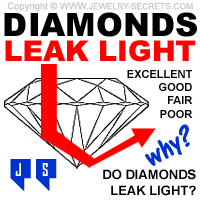
Diamonds leak?
YES! Diamonds leak light, which means, they’re losing brilliance, sparkle, fire and life.
And let’s face it, the sparkle in a diamond is why we love them so much. If it wasn’t for this dazzling dance of light, diamonds wouldn’t be so beautiful, and people probably wouldn’t buy them.
We love the bling.
Sadly, some people are losing light and don’t even know it.
How do diamonds leak light?
They leak light because of the way they are cut.
You probably all know that the round brilliant cut diamond looks like this:

But… that’s not entirely true.
That image is what a standard diamond with excellent proportions looks like.
Which is a little bit different than a diamond with…
Bad proportions
For all diamonds are not cut the same. Some diamonds are cut thin and narrow, while others are cut deep and lumpy.
Compare these poor cuts of diamond to that of an ideal cut diamond.
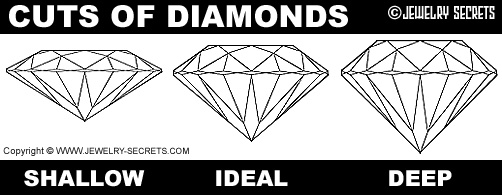
If you look at brilliant cut diamonds that are cut too shallow or too deep, you’ll see that they lose light.
Light literally goes right out the bottom of the diamond as this image shows:
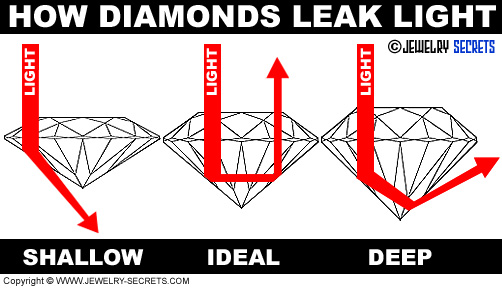
When the light goes out the bottom: No sparkle!
Better proportions
A well cut diamond will have a properly cut table and depth percentage (which is easy to tell with GIA’s new cut grade).
When the table and depth is cut with correct proportions, light will enter through the crown, hit the base of the diamond at the correct critical angle, bounce across to the other side, then get sent back out the top of the diamond in multiple flashes of light and sparkle.
The white flashes of light are called brilliance (or brightness), and the colored flashes of light are called fire (which is caused by the light stream splitting like a rainbow).
When the table or depth is too extreme, the light doesn’t bounce across, doesn’t get reflected out, it just shoots out of the base of the diamond and gets lost.
So the table and depth percentages are important if you want to maximize beauty, light, brilliance and sparkle in your stone.
Table percentages
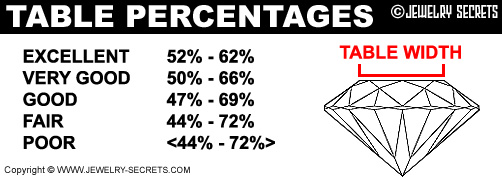
The table percentages are:
Excellent………….52% – 62%
Very Good………….50% – 66%
Good………….47% – 69%
Fair………….44% – 72%
Poor………….<44% - 72%>
As you can see, excellent table percentages should be between 52% and 62%. But most round diamonds that you see on the market today will be closer to the good proportion numbers: 47% – 69%.
I say “most” but trust me, you will still find some diamonds that are poor in cut. It’s important to spot them and to know what to avoid.
A poor table percent is less than 44% and more than 72%. See examples below of poorly cut diamonds.
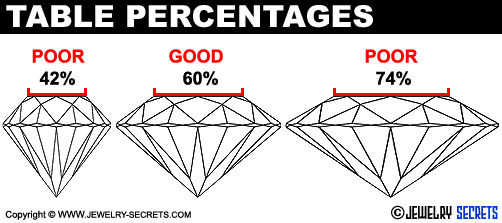
Just recently I had a reader write in. She was pondering the purchase of a diamond that had a table percentage of 73% and a depth of 74%.
My advice was: Skip it!
The closer you can get to a table percentage of 52-62% (excellent) the better!
Depth percentages
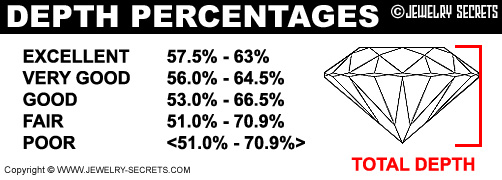
The good proportions for depth are:
Excellent………….57.5% – 63%
Very Good………….56% – 64.5%
Good………….53.0% – 66.5%
Fair………….51.0% – 70.9%
Poor………….<51.0% - 70.9%>
As you can see “good” proportions should fall between 53.2% and 66.5%.
The depth is the entire depth of the diamond, which includes the crown height, the girdle thickness and the depth of the pavilion (which is the base of the diamond).
The depth is important because this is what helps the light bounce across and come back out the top of the diamond.
Take a peek at what poor depth looks like up against an ideal cut diamond.
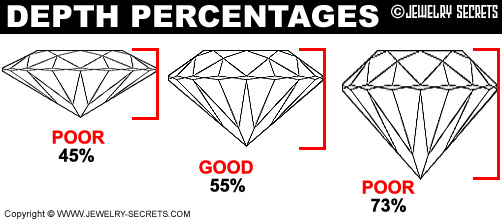
Fish-eye diamonds
If your diamond is too shallow, like a 45% depth percentage, then your diamond will not only leak light, but it will create a weird dark ring around the pavilion that looks like a fish-eye (see image below).
Not very pretty.
Plus, a shallow stone can be chipped or broken more easily. This is because the edges of the diamond are thinner and more vulnerable to strikes.
Skip the narrow stones. They will appear much larger than they really are. i.e. a One carat diamond will actually look more like a 1.50 carat diamond. These larger looking diamonds are called “spread stones“. They look big, but lack light and life and are fragile.
DON’T BUY THEM!
See picture below that shows a fish-eye diamond and a nail head diamond.
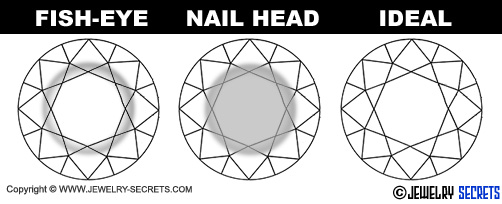
Nail head diamonds
Now, if your diamond is too deep on the other hand, like 73%, then your diamond will look dull, dark and lifeless.
It will look like it has a large dark circle in the center of your stone. Or as jewelers refer to them: nail heads.
Poor depth percentages are anything less than 51.1%, or anything more than 70.2%.
It’s wise to get a diamond that has a depth that’s at least in between 53.2% and 66.5%. Those percentages are good and you’ll get a lot of brilliance and sparkle.
But there is something better…
Ideal percentages
An ideal percentage is a diamond that is cut to ideal proportions.
Ideal means that the diamond is cut in such a way that it maximizes light and gives you as much brilliance and sparkle and fire as possible from the stone.
Ideal proportions are:

In an ideal cut diamond (devised by Marcel Tolkowsky in 1919), the table percentage is slightly different than that of an excellent cut. An ideal table has only a 4% variance. That’s slim.
The ideal standard states that an ideal depth should be between 57.5% and 63%. That gives you a margin of 5.5%. Not a lot or room for perfection.
A diamond with an ideal table and an ideal depth will give you more brilliance and sparkle than any other cut of diamond. More bang for your buck.
Why not cut all diamonds ideal?
Why don’t diamond cutters just cut all diamonds to ideal proportions?
Because of profit and the fact that they don’t want to waste any of the diamond rock.
See the picture below to explain:
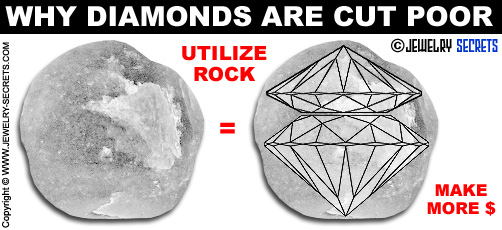
As you can see, one excellent cut diamond can be cut from the parent rock, along with one shallow cut diamond. This way they utilize all of the rock, get 2 diamonds out of it, and make as much money as possible.
Why waste the diamond, right?
Diamond certificates
If you want to see what the percentages are for any given diamond, look at a diamond report. Most of them, like this GIA (The Gemological Institute of America) diamond report below, will list the table and depth percentage right on the report. Take a look:
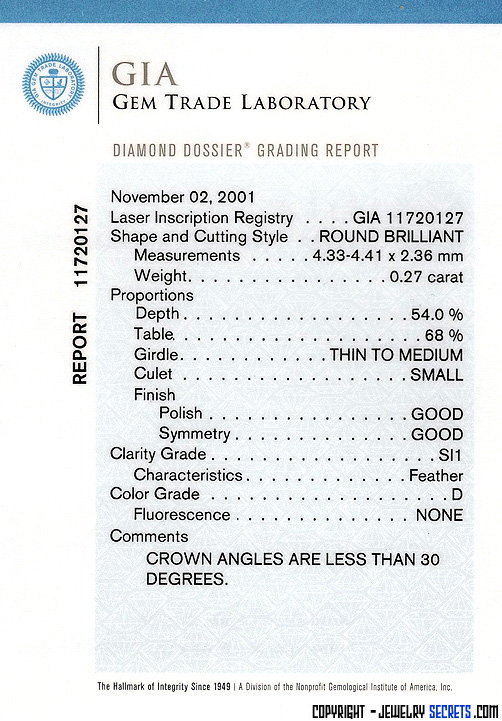
(Percentages are are shown under the diamond profile on newer diamond reports.)
The closer you can get to ideal, the more flashes of light you will have.
So yes, diamonds can leak light.
It makes you wonder, why would anyone want to buy a diamond that doesn’t sparkle as much as it could?
Sparkle is what makes a diamond beautiful.
It all comes down to price.
Diamonds with a poor cut (poor depth and poor table percentages) will often be cheaper than better cuts of diamond.
You’ll notice this if you see a diamond of the exact same carat weight, clarity and color priced at $1,000 less. Beware!
These cuts will save you money, but you sacrifice light and beauty. It’s your choice.
Always check your table and depth.
Here is an example of a GIA diamond certificate with a poor cut.
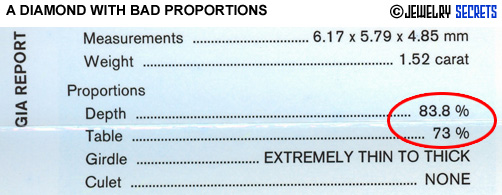
Crazy eh?
Here’s a GIA diamond certificate with an ideal cut.
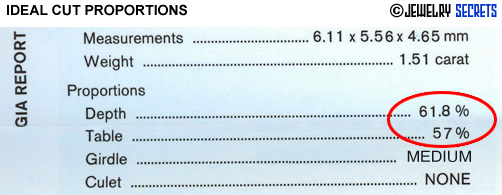
That diamond will definitely rock her world.
Because if the diamond doesn’t have light or life…
Why bother?
And if all these percentages make you crazy, then don’t sweat it. GIA made it so much easier to understand. You don’t have to look at the table or depth anymore… Just look at the cut grade.
In 2005, GIA came out with a new cut grading system that lists the actual cut of the diamond.
GIA’s new cut grades.
The 5 cut grades are:
- Excellent
- Very Good
- Good
- Fair
- Poor
Excellent is the best cut grade you can buy.
All you have to do is to look at the newer GIA diamond reports and you’ll see what the cut grades are. If it says “excellent” or “very good” (at the least), then you will have excellent proportions.
BUT…
If you want the best cut you could ever get (ideal), then you also need to look at the polish and symmetry grades as well.
Those too should be listed as “excellent” or “very good” (nothing lower).
So if you get a diamond that’s cut excellent, with excellent polish and symmetry, that’s called a super ideal cut, and it gives you those lovely little hearts and arrows pattern that we all love and desire (as seen under a hearts and arrows gemscope).
Triple excellent is the mark of a perfectly cut diamond.
See some triple excellent cut diamonds here (called True Hearts).
And that’s the best cut you can get.
With no leaking at all.
Cheers! :)


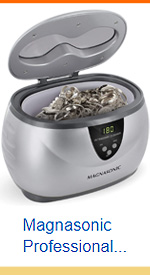

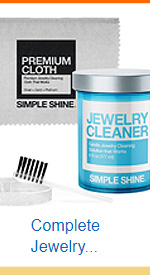
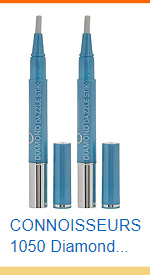
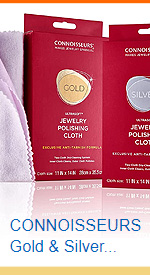
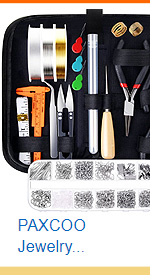
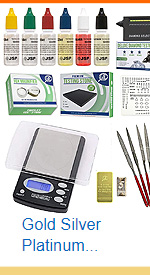
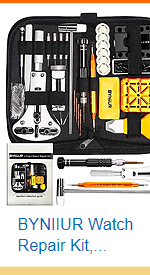
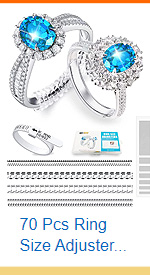
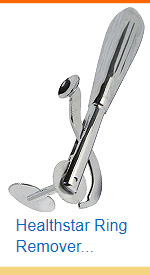
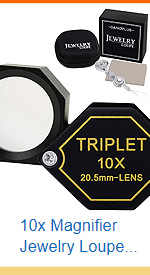
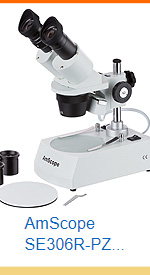




I personally don’t care for 60/60 for rings, although there are certainly exceptions out there. For an engagement ring, I prefer a 55-56% table, with a depth of around 61%